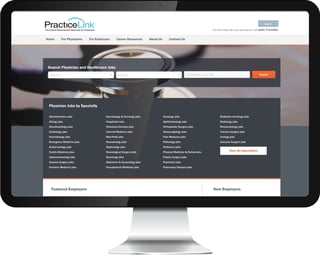
We recently conducted an open-ended survey of physician recruiters to find out what bad recruitment habits you thought were most pervasive. The same five mistakes came up over and over again. Here’s a look at what they were—and how to avoid them.
1. The Post-and-Pray
When you’ve got a lot on your to-do list—as most recruiters do—it’s tempting to toss a cursory job description online and turn to other tasks in hopes that the opportunity will sell itself to physician candidates. In reality, you’d save your future self time by carefully crafting your job descriptions early on and actively sourcing candidates who you think would fit the bill.
To write an appealing job description, talk with your other physicians, specifically those hired for similar positions. What drew them to apply? What were their biggest considerations? Perfecting your post may not seem like an urgent priority, but that doesn’t mean it’s not important. Try designating specific times when you’ll focus on writing thorough and enticing descriptions for your open positions. Your audience is physicians with limited time and myriad job options, so you’ve got to show them what sets your opportunities and organization apart.
2. The Follow-up Flub
Failure to follow up with candidates—or even just waiting too long to do so—was far and away the most frequent mistake recruiters noted in our survey. This, too, often results from the hectic pace of recruiters’ schedules and the sheer number of candidates you may have to keep up with.
So how do you ensure you follow through with follow-up? Schedule it and track it. Use the Notes tool in PracticeLink's onTrack RMS to keep track of your progress with each candidate. Multiple survey respondents advised that recruiters schedule a specific time every day and even set reminders to turn their attention to follow-ups.
Most importantly, stick to the plan that you’ve made. If you’ve let someone drop off by accident, apologize and follow up anyway. Steady communication demonstrates interest in a candidate and breeds familiarity over time, which will surely work in your favor for candidates courting multiple opportunities.
3. The Unqualified Candidate
Another mistake recruiters make all too often is moving candidates through the recruitment funnel prematurely. If you don’t screen a candidate adequately, you may bring someone in for an interview who should’ve been dropped after a phone call. Overconfidence about a candidate’s qualifications can prove costly.
Avoid this by reviewing CVs critically for time lapses, checking for background issues and asking candidates the hard questions before they show up on-site. Doing your homework on every candidate takes an assertive attitude up front, but it pays dividends later on.
4. The Fatal Assumption
Recruiters also told us that one recurring mistake is to stop recruiting when a candidate looks like a sealed deal—and then have a rude awakening when the candidate turns down the job. It’s also possible to make assumptions about the ease of a search. A seemingly easy-to-fill slot may remain open months down the road if you assume you don’t need to devote much time or effort to it.
Don’t fall prey to faulty assumptions: Try your best to devote equal time to each search, even the ones that seem easy. And don’t stop recruiting until long after a candidate signs. As one respondent said, “Don’t count the placement until the ink is dry (and possibly until they walk through the door on their first day!).”
5. The Reactive Routine
Similarly, it’s possible, when things get hectic, to let your whole recruitment routine become reactive rather than proactive. If you focus only on current needs with no eye toward the future, you’ll find yourself unprepared when more positions pop up.
Combat this by using past data to forecast future needs and by building your brand continuously—even when hiring needs seem slow. Rather than focusing all your attention on current negotiations, keep building a pipeline of candidates for specialties you anticipate you’ll need later. If you’re spread too thin, engage the C-suite to hire more recruiters. Show them the savings that in-house recruiters provide over firms, and work to build a team large enough that it’s always planning ahead.









